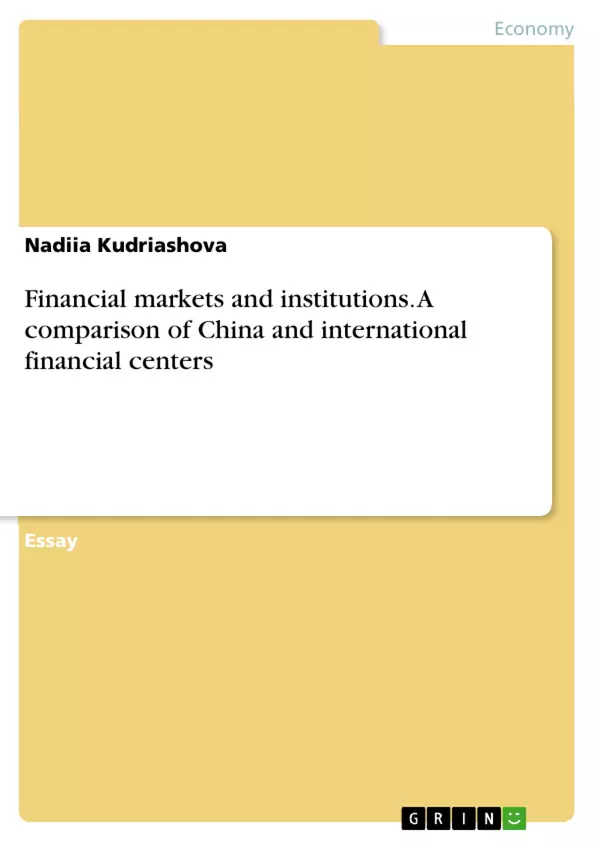International Finance Center (IFC) are an integral part of the modern international financial economy. One of its basic components is the availability of developed national financial markets, actively interacting with similar markets in other countries. As an example, the United States can lead the UK, Japan, in economic development which play an important role the financial markets, and the major cities of these countries (New York, London, Tokyo), are the major international financial centers. Cities can be seen as the gateway to the global economy. They are important for the functioning of both national and global economy, since they are concentrated huge financial, informational and intellectual resources, based most of the major industrial, commercial, financial and service companies, specialized credit and financial institutions and banks.
In addition to traditional MFC in the last decades of the 20th century a number of new financial centers competing for the role of international. The acceleration of globalization and especially its financial component, led to an increase in strength and influence regional financial centers, in particular, such as Hong Kong (Hong Kong). The financial market of China, which is traditionally considered to be emerging financial markets have long been a mature international financial centers that have an impact not only on the regional economy, but also in the distribution of global capital flows.
The study of the functioning of the MFC, their development trends is the most important area for the understanding of the new global economy, its characteristics and movement mechanisms. At the same time identifying new trends in the development of Asian financial centers, particularly their inclusion in the competition for international corporations have mastered the financial market, is both scientific and practical interest. This makes it possible to identify local features of financial globalization as a result of the connection and the active development of the Asia-Pacific Economic Space with new financial centers, show their role, prospects and competitiveness in the global economy. Of particular importance is the study of the development of Chinese financial market, especially given the fact that the IMF has recognized the yuan a freely usable currency, reflecting the expanding role of China in world trade, a significant increase in the use of the yuan in the international scale and the growth of operations with it.
Inhaltsverzeichnis (Table of Contents)
- Introduction
- Financial centers and financial markets today: categorization, trends, and prospects
- Global financial centers
- London - the oldest financial center
Zielsetzung und Themenschwerpunkte (Objectives and Key Themes)
This study aims to analyze the functioning and development trends of global financial centers (GFCs) with a particular focus on China and its role in the international financial system. The study examines the competitive advantages and vulnerabilities of leading GFCs, shedding light on the dynamics of the global financial system.
- Evolution and categorization of global financial centers
- Impact of globalization on financial centers
- Role of China in the global financial system
- Comparison of Chinese and international financial centers
- Analysis of the global financial system and its key players
Zusammenfassung der Kapitel (Chapter Summaries)
- Introduction: Introduces the concept of International Finance Centers (IFCs) and their significance in the global financial economy. Highlights the role of major financial centers like New York, London, and Tokyo, and discusses the emergence of new financial centers, particularly in Asia, including Hong Kong and China. Emphasizes the importance of studying the functioning and development of GFCs to understand the global economy.
- Financial centers and financial markets today: categorization, trends, and prospects: Discusses the categorization of financial centers, including global, regional, local, niche, and specialized centers. Examines various global financial center indices, such as the Global Financial Centers Index (GFCI) and the International Financial Centers Development Index (IFCD), highlighting their importance in assessing the development of financial centers worldwide.
- Global financial centers: Delves into the characteristics of global financial centers, their role in attracting capital, managing cash flows, and creating new financial instruments. Explores different classifications of GFCs based on their reach and influence, providing examples of centers in different categories.
- London - the oldest financial center: Examines London's historical significance as a financial center, highlighting its developed stock markets, banking system, asset management, and insurance sector. Emphasizes London's position as a leading center for foreign direct investment, particularly in Europe, despite the implications of Brexit.
Schlüsselwörter (Keywords)
The study focuses on the following key areas: international financial centers, financial globalization, global financial system, Chinese financial market, financial market development, competitive advantages, vulnerabilities, London, New York, Hong Kong, Shanghai, Singapore, Asian financial centers, yuan internationalization, BRICS, financial crisis, institutionalization.
- Quote paper
- Nadiia Kudriashova (Author), 2017, Financial markets and institutions. A comparison of China and international financial centers, Munich, GRIN Verlag, https://www.grin.com/document/458144



